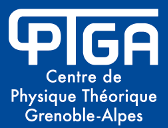Mini-Workshop on Pairing with Strong Correlations in Cold Atom and Nuclear Systems
There will be a mini-workshop on pairing on October 4-5 at LPMMC Grenoble. The sessions shall start on thursday Oct.4 at 14h and end on friday Oct.5 at noon. There are forseen eight talks in a light, discussion oriented program. Each talk may last ±45 mins.
Speakers with preliminary title are :
Thursday, October 4, 2018
| 1 | 14-15 | L. Amico | Bethe Ansatz approach to the pairing fluctuations in the mesoscopic regime |
| 2 | 15-16 | M. Urban | Screening and anti-screening of the pairing interaction in low-density neutron matter. |
| 3 | 16-17 | D. Feinberg | Quartet and multipair resonances in multiterminal superconducting Josephson junctions |
| × | 17-17:30 | coffe break | |
| 4 | 17:30-18:30 | P. Schuck | Critical temperature of pairing from an approach for the t-matrix including consitently quantum fluctuations. Applications to the pairing model. Pseudo-gap. |
| 5 | 18:30-19:00 | E. Krotscheck | Variational and Parquet—diagram theory for strongly correlated normal and superfluid systems |
Friday, October 5
| 6 | 9-10 | G. Roepke | Pairing and Quartetting— Some Results and Open Problems. |
| 7 | 10-11 | P. Pieri | Comparing different t-matrix approaches for a Fermi gas throughout the BCS-BEC crossover. |
| 8 | 11-12 | G. Strinati | Gap equation with pairing correlations beyond mean field and its equivalence to a Hugenholtz-Pines condition for fermion pairs. |
ATTENTION : en raison de la mise en application avancée du plan Vigipirate, toutes les personnes qui ne possèdent pas de badge CNRS doivent signaler leur venue avant le mardi 2 octobre, afin d’ajouter leur nom à la liste des personnes autorisées à entrer sur le site.
Abstracts :
1) Luigi AMICO :
Luigi Amico [7]
Bethe Ansatz approach to the pairing fluctuations in the mesoscopic
regime
I review the exact treatment of the pairing correlation functions in the canonical ensemble. The key for the calculations has been provided by relating the discrete BCS model to known integrable theories corresponding to the so called Gaudin magnets with suitable boundary terms. In the present case the correlation functions can be accessed beyond the formal level, allowing the description of the cross-over from few electrons to the thermodynamic limit. In particular, we summarize the results on the finite size scaling behavior of the canonical pairing clarifying some puzzles emerged in the past. Some recent developments and applications are outlined.
2) Michael URBAN :
Michael URBAN [5]
Screening and anti-screening of the pairing interaction in low-density neutron matter.
We study pairing in low-density neutron matter including the screening interaction due to the exchange of particle-hole and RPA excitations. As bare force we employ the effective low-momentum interaction V_low-k while the Fermi-liquid parameters are taken from a phenomenological energy density functional which correctly reproduces the equation of state of neutron matter. At low density, we find screening, i.e., pairing is reduced, while at higher densities, we find anti-screening, i.e., pairing is enhanced. This enhancement is mostly due to the strongly attractive Landau parameter f_0. We discuss in detail the critical temperature T_c in the limit of low densities and show that the suppression of T_c predicted by Gor’kov and Melik-Barkhudarov can only be reproduced if the cutoff of the V_low-k interaction is scaled with the Fermi momentum. We also discuss the effect of non-condensed pairs on the density dependence of T_c in the framework of the Nozières-Schmitt-Rink theory.
3) Denis FEINBERG :
Quartet and multipair resonances in multiterminal superconducting Josephson
junctions
Denis FEINBERG, R. Mélin [8]
A Josephson junction establishes phase rigidity between two superconductors via a pair tunnelling term. In BCS superconductors, this results from virtual breaking of Cooper pairs, or equivalently, in an electron/hole language, from Andreev reflection. By extension, in a three-terminal superconducting junction with commensurate biases, a resonant multi-pair tunnelling process occurs that is energy-conserving and promotes phase rigidity between the three superconductors altogether, and not two by two as in ordinary junctions. The simplest case is the formation of a quartet resonance at the multiple Josephson junction, letting two pairs tunnelling altogether in a single quantum process.
4) Peter SCHUCK :
Critical temperature of pairing from an approach for the t-matrix including consitently quantum fluctuations. Applications to the pairing model. Pseudo-gap.
A Bethe-Salpeter equation with a single frequency kernel is presented. The static part if this kernel describes in a self-consistent way pairing fluctuations or a mean field for two particle bound states. The theory is applied to the many level pairing (Richardson) model at finite temperature. Very good results in comparison with exact ones are obtained. The appearance of a pseudo-gap is discussed.
5) Eckhard KROTSCHECK :
Variational and Parquet—diagram theory for strongly correlated normal and superfluid systems
Eckhard KROTSCHECK [9]
We develop the full variational and correlated basis functions/parquet-diagram theory of strongly interacting superfluid systems. In the first part of this contribution we will highlight the connections between the Euler equations for the Jastrow-Feenberg (or, in a more recent language ``fixed-node’’) wave function and both the RPA and the Bethe Goldstone equation and show that both are contained, in a local approximation, in the variational wave function.
We then derive the fully optimized Fermi-Hypernetted Chain (FHNC-EL) equations for a superfluid system. Close examination of the procedure reveals that it is essential to go beyond the usual Jastrow-Feenberg approximation and to include the exact particle-hole propagator to guarantee the correct stability range.
If time permits, we will describe the application the method to neutron matter and low density Fermi liquids interacting via the Lennard-Jones model interaction and the Poeschl-Teller interaction. In all cases, we find a lowering of the superfluid gap and — in the Lennard-Jones liquid and Poeschl-Teller gas — a significant change of the stability range.
6) Gerd RÖPKE :
Gerd RÖPKE [4]
Pairing and Quartetting— Some Results and Open Problems.
The very successful single quasiparticle approaches to nuclear systems (equation of state, nuclear structure, nuclear reactions, transport models) are improved taking into account few-body correlations. Nowadays, pairing is a well established concept in nuclear physics. A subsequent step is the inclusion of four-particle correlations. Signatures of alpha -like quartetting are found in matter at low densities. For instance, they are relevant for the nuclear matter equation of state, the Hoyle state, and the alpha decay of heavy nuclei. Quartetting in homogeneous matter at finite temperature is treated using a Green-function approach. For inhomogeneous nuclear systems like nuclei, a quartetting wave function approach can be given which considers the motion of a quartet in the mean-field of the nuclear medium. Results for 212Po and 20Ne are shown. A self-consistent approach to describe quartetting is given by the THSR variational approach which uses Gaussian wave functions and is limited so far to nuclear mass numbers up to 20.
7) Pierbiagio PIERI :
Comparing different t-matrix approaches for a Fermi gas throughout the BCS-BEC crossover.
Michele Pini [1] , Pierbiagio Pieri [1], [2], Giancarlo Calvanese Strinati [1], [2], [3]
Different many-body diagrammatic theories, all based on the t-matrix self-energy but distinct for the degree of self-consistency, have been proposed in the literature to describe the normal phase of a Fermi gas undergoing the BCS-BEC crossover. In this talk, I will present a comprehensive comparison of the results obtained with the above different t-matrix approaches for both thermodynamic and dynamic quantities. The high accuracy of our implementation of the different schemes throughout the BCS-BEC crossover allows us to analyze also fine details like the residual interaction between the composite bosons in the BEC limit (correcting some statements in the literature), or to point out the inadequacy of certain approximations normally used in the implementation of some of the above schemes. Finally, I will discuss the results of a recent experiment aimed at measuring the number of fermion pairs in the normal phase of an ultra-cold Fermi gas (Paintner et al., arXiv:1803.10598) in the light of the above t-matrix approaches.
8) Giancarlo STRINATI :
Giancarlo Strinati [1]
Gap equation with pairing correlations beyond mean field and its equivalence to a Hugenholtz-Pines condition for fermion pairs.
The equation for the gap parameter represents the main equation of the pairing theory of superconductivity. Although it is formally defined through a single-particle property, physically it reflects the pairing correlations between opposite-spin fermions. To exploit this physical connection and cast the gap equation in an alternative form which explicitly highlights these two-particle correlations, it is shown that the gap equation is equivalent to a Hugenholtz-Pines condition for fermion pairs. At a formal level, a direct connection is established in this way between the treatment of the condensate fraction in condensate systems of fermions and bosons. At a practical level, the use of this alternative form of the gap equation is expected to make easier the inclusion of pairing fluctuations beyond mean field. As a proof-of-concept of the new method, the modified form of the gap equation is applied to the long-pending problem about the inclusion of the Gorkov-Melik-Barkhudarov correction across the whole BCS-BEC crossover, from the BCS limit of strongly overlapping Cooper pairs to the BEC limit of dilute composite bosons, and for all temperatures in the superfluid phase. The numerical calculations yield excellent agreement with the recently determined experimental values of the gap parameter for an ultra-cold Fermi gas in the intermediate regime between BCS and BEC, as well as with the available quantum Monte Carlo data in the same regime.
[7] Dipartimento di Fisica e Astronomia, Via S. Sofia 64, 95127 Catania, Italy / Centre for Quantum Technologies, National University of Singapore, 3 Science Drive 2, Singapore 117543, Singapore / MajuLab, CNRS-UNS-NUS-NTU International Joint Research Unit, UMI 3654, Singapore / CNR-MATIS-IMM & INFN-Sezione di Catania, Via S. Sofia 64, 95127 Catania, Italy and LANEF ’Chaire d’excellence’, Université Grenoble-Alpes & CNRS, F-38000 Grenoble, France
[5] Institut de Physique Nucleaire Orsay (IPNO)
[8] Institut Néel, CNRS and UGA, Grenoble
[6] LPMMC, CNRS, UGA Grenoble
[9] University at Buffalo SUNY
[4] University of Rostock, Germany
[2] INFN, Sezione di Perugia, 06123, Perugia (PG), Italy
[3] CNR-INO, Istituto Nazionale di Ottica, Sede di Firenze, 50125 Firenze (FI), Italy
[1] School of Science and Technology, Physics Division, University of Camerino, 62032, Camerino (MC), Italy


